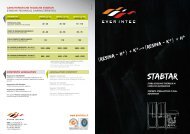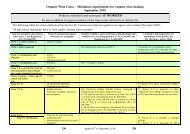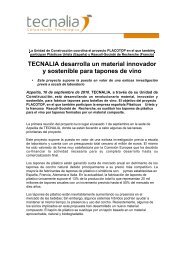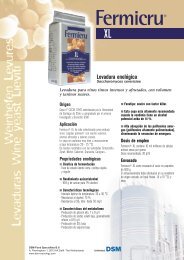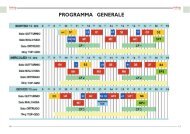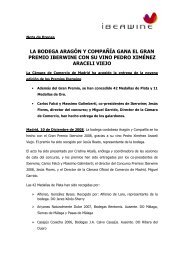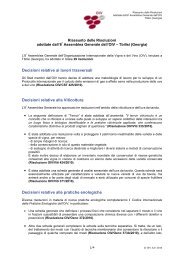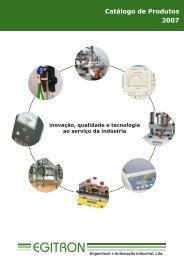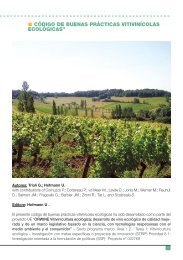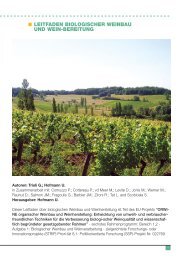Codice di buone pratiche per la viticoltura e l'enologia ... - Infowine
Codice di buone pratiche per la viticoltura e l'enologia ... - Infowine
Codice di buone pratiche per la viticoltura e l'enologia ... - Infowine
You also want an ePaper? Increase the reach of your titles
YUMPU automatically turns print PDFs into web optimized ePapers that Google loves.
188<br />
4.2. Inoculo dei lieviti attraverso l’attivazione (Trioli, G.)<br />
L’attivazione è un metodo semplice ed economico <strong>per</strong> garantire il predominio dei ceppi <strong>di</strong> lieviti selezionati<br />
e il corretto svolgimento <strong>di</strong> una fermentazione alcolica.<br />
Questo metodo si basa sul<strong>la</strong> preparazione preliminare <strong>di</strong> una coltura <strong>di</strong> starter con un’alta carica <strong>di</strong><br />
lieviti secchi attivi, da utilizzare <strong>per</strong> inocu<strong>la</strong>re <strong>la</strong> massa <strong>di</strong> mosto da fermentare.<br />
Una forte attività fermentativa dei lieviti fin dalle prime fasi svolge un ruolo <strong>di</strong> protezione nei confronti<br />
delle contaminazioni microbiche e dell’ossidazione che consente <strong>di</strong> ridurre od omettere l’utilizzo<br />
dell’anidride solforosa<br />
Fase O<strong>per</strong>azione Esempio <strong>per</strong> 20 hL Commenti<br />
Fase 1 Due giorni prima del<strong>la</strong> data stabilita<br />
<strong>per</strong> <strong>la</strong> vendemmia, raccogliere<br />
e trasformare un lotto equivalente<br />
al 5-10% del totale del<strong>la</strong><br />
massa, in funzione del tipo <strong>di</strong><br />
vasche che si hanno a <strong>di</strong>sposizione<br />
Fase 2 Una volta che <strong>la</strong> partita è pronta<br />
<strong>per</strong> l’inoculo, reidratare i lieviti<br />
selezionati seguendo le istruzioni<br />
fornite dal produttore<br />
Fase 3 Inocu<strong>la</strong>re il lievito reidratato e<br />
omogeneare <strong>la</strong> massa<br />
Fase 4 La fermentazione inizia dopo<br />
poche ore. Control<strong>la</strong>re <strong>la</strong> tem<strong>per</strong>atura<br />
e <strong>la</strong> formazione <strong>di</strong> schiuma<br />
Fase 5 Due giorni dopo, preparare <strong>la</strong><br />
massa principale <strong>di</strong> mosto da<br />
fermentare<br />
Fase 6 Control<strong>la</strong>re <strong>la</strong> tem<strong>per</strong>atura del<strong>la</strong><br />
massa principale: se <strong>la</strong> <strong>di</strong>fferenza<br />
è > 10°C, acclimatare <strong>la</strong> coltura<br />
starter a tem<strong>per</strong>ature interme<strong>di</strong>e<br />
Fase 7 Inocu<strong>la</strong>re <strong>la</strong> massa principale<br />
con <strong>la</strong> coltura starter<br />
Preparare 1-2 hL <strong>di</strong> mosto in<br />
un contenitore con un volume<br />
> 3 hL<br />
Reidratare 500 g <strong>di</strong> lievito<br />
secco attivo in 5 litri d’acqua<br />
(40-42°C) <strong>per</strong> un massimo <strong>di</strong><br />
30 minuti<br />
Aggiungere <strong>la</strong> sospensione <strong>di</strong><br />
lieviti al mosto agitando<br />
Raffreddare se <strong>la</strong> tem<strong>per</strong>atura<br />
su<strong>per</strong>a i 30°C (immergendo<br />
contenitori <strong>di</strong> p<strong>la</strong>stica pieni<br />
d’acqua gelida o utilizzando<br />
ghiaccio secco)<br />
Effettuare l’analisi dell’azoto<br />
prontamente assimi<strong>la</strong>bile e<br />
aggiungere ammonio fosfato e<br />
tiamina in funzione delle<br />
necessità<br />
Aggiungere 1-2 hL <strong>di</strong> mosto<br />
freddo al<strong>la</strong> coltura starter e<br />
attendere 1-2 ore prima <strong>di</strong><br />
effettuare l’inoculo<br />
Aggiungere 2 hL <strong>di</strong> coltura<br />
starter ai 20 hL principali e<br />
omogeneizzare <strong>la</strong> massa Il<br />
Tabel<strong>la</strong> 6: Inoculo dei lieviti attraverso l’attivazione: note <strong>pratiche</strong>.<br />
In alcuni casi, può risultare più<br />
semplice utilizzare, <strong>per</strong> l’attivazione,<br />
una partita <strong>di</strong> uve che<br />
non provengono dallo stesso<br />
vigneto, ma che possono<br />
essere vinificate insieme al<strong>la</strong><br />
massa principale<br />
Il rispetto del<strong>la</strong> tem<strong>per</strong>atura<br />
dell’acqua e dei tempi <strong>di</strong> reidratazione<br />
è importante <strong>per</strong><br />
garantire una buona vitalità dei<br />
lieviti<br />
La partita <strong>di</strong> mosto è stata inocu<strong>la</strong>ta<br />
con 250-500 g/hL (25<br />
g/hL calco<strong>la</strong>ti sul<strong>la</strong> massa finale)<br />
equivalente a 50-100 milioni<br />
<strong>di</strong> cellule/mL<br />
Il lievito inizia a fermentare e a<br />
moltiplicarsi. In due giorni il loro<br />
numero aumenta <strong>di</strong> almeno 10<br />
volte<br />
L’ossigeno <strong>di</strong>sciolto nel mosto<br />
fresco – compatibilmente con<br />
<strong>la</strong> strategia <strong>di</strong> vinificazione scelta<br />
– favorisce lo sviluppo dei<br />
lieviti<br />
Uno shock termico può essere<br />
<strong>per</strong>icoloso <strong>per</strong> i lieviti<br />
mosto fresco viene inocu<strong>la</strong>to<br />
con una popo<strong>la</strong>zione <strong>di</strong> lieviti <strong>di</strong><br />
50-100 milioni <strong>di</strong> cellule/mL<br />
Nota: in alcune strutture può rive<strong>la</strong>rsi più conveniente usare, <strong>per</strong> <strong>la</strong> preparazione del<strong>la</strong> coltura starter,<br />
<strong>la</strong> stessa vasca che verrà utilizzata <strong>per</strong> <strong>la</strong> fermentazione. In questo caso il mosto fresco viene<br />
aggiunto <strong>di</strong>rettamente al<strong>la</strong> coltura starter dopo due giorni.




